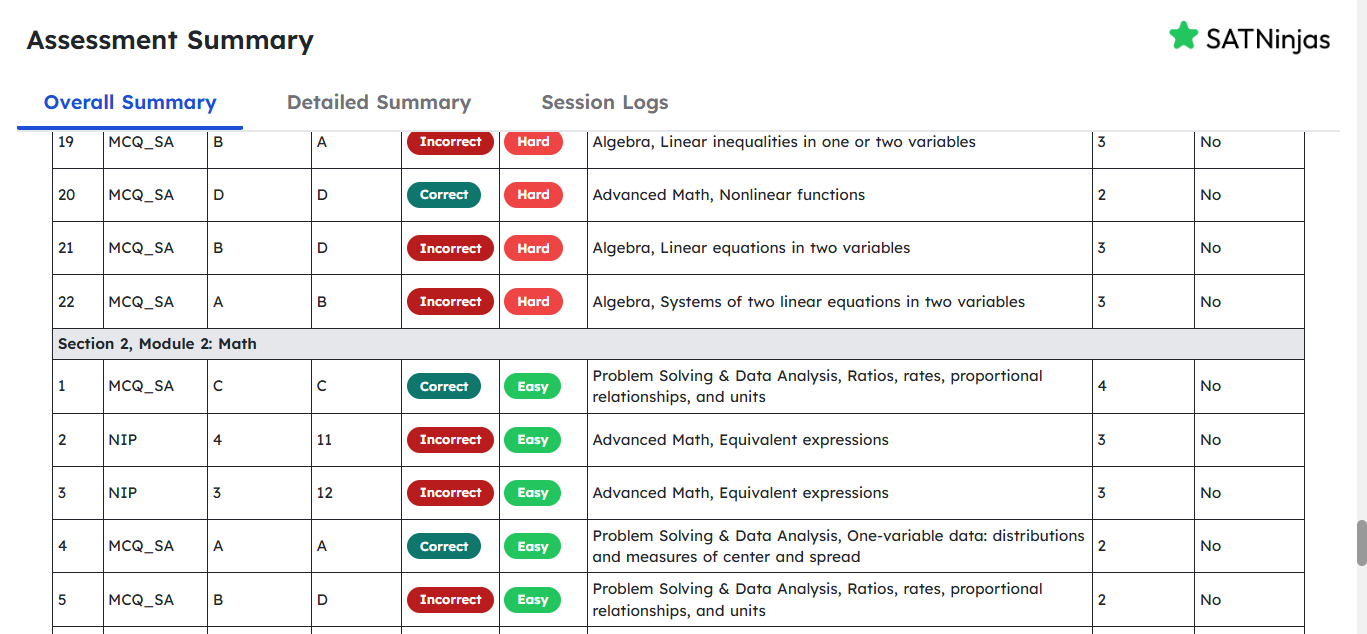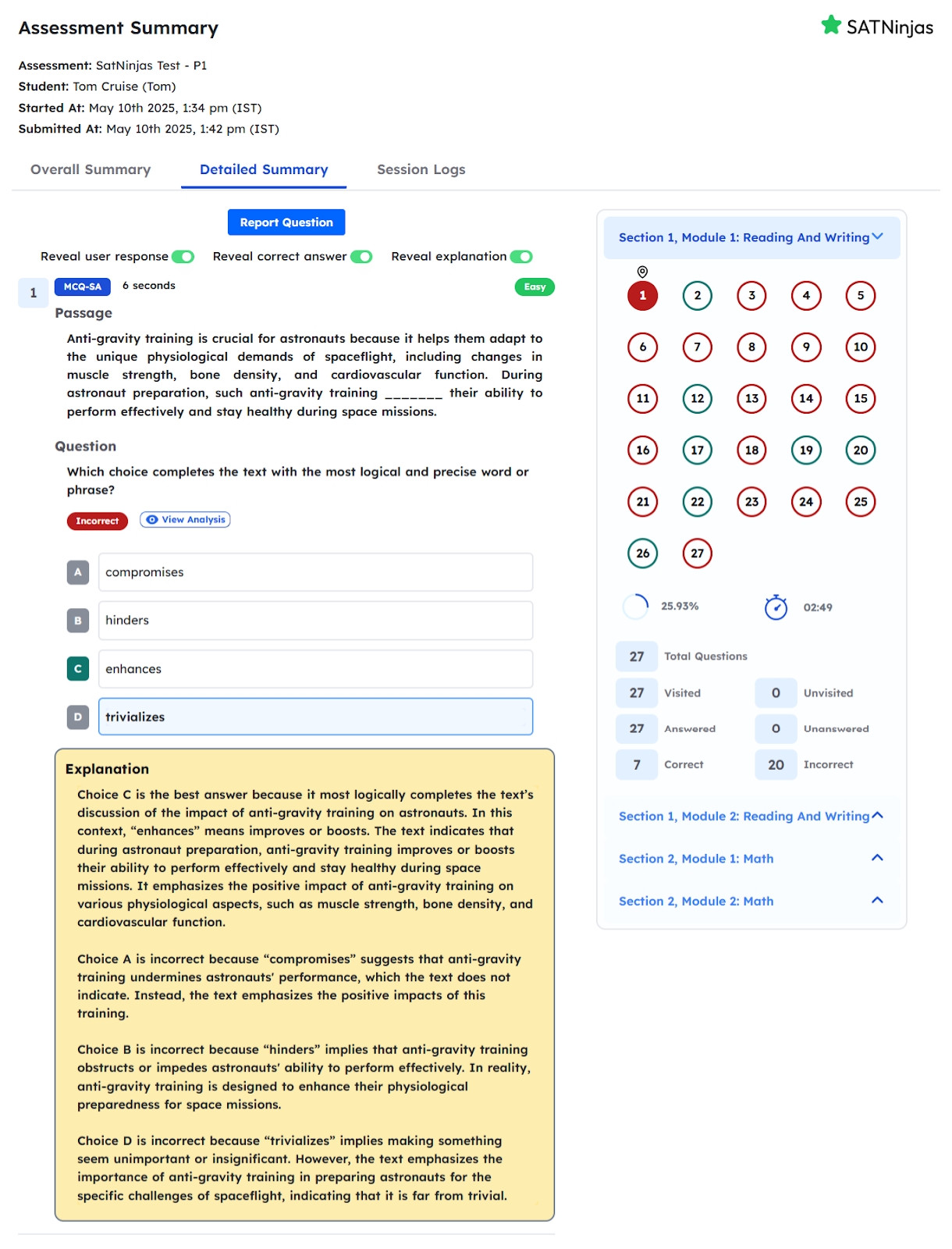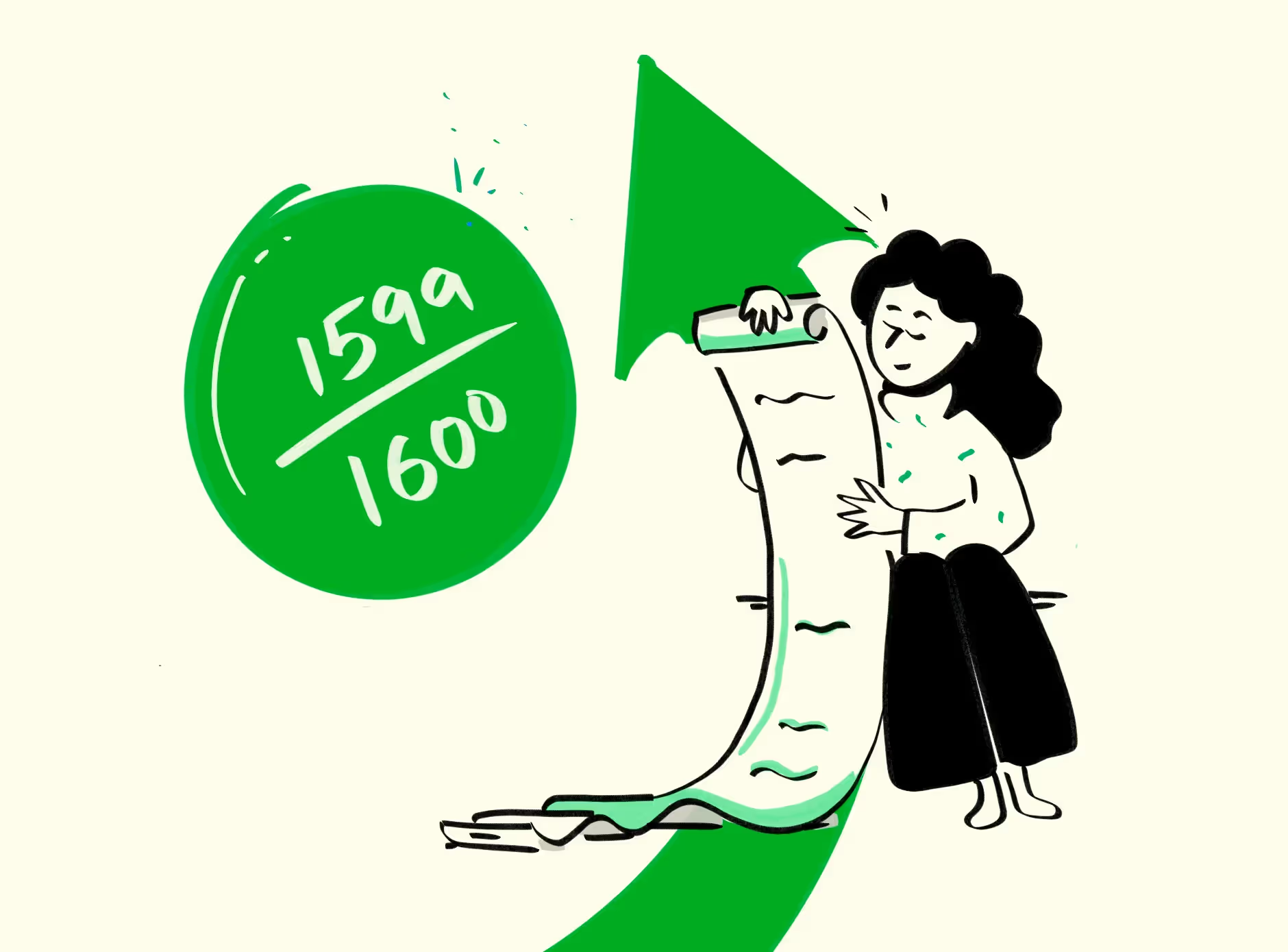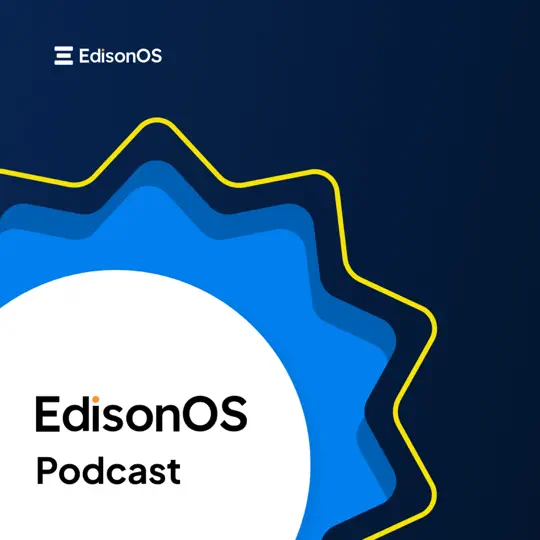




Key Takeaways
- SAT is adaptive, ACT is linear with more straightforward questions.
- SAT offers more time per question, ACT demands faster pacing.
- Choose based on strengths, test style preference, and college requirements.
Students have the freedom to choose between the SAT and the ACT. Because this choice significantly impacts their college admission process, understanding the SAT vs ACT comparison is very important for students.
On the surface, both the SAT and the ACT are similar college admission tests. They assess mathematical, reasoning, and language skills in order to determine a student’s college-readiness.
However, the two tests have some unique features. So questions like ‘Which is harder: SAT or ACT?’ cannot be answered without context. For instance, the SAT is an adaptive test while the ACT is a linear test. Per question, more time is available in the SAT than in the ACT. However, according to some students and tutors, the SAT requires deeper thinking, so the time advantage isn’t that attractive.
In this post, we analyse all the important differences between SAT and ACT. This will help you guide your students make the right decision and prepare better. But first, let us begin with a quick comparison.
SAT vs ACT difference: A Quick comparison table
The below table provides the foundation of the detailed analysis of where the SAT and the ACT differ.
Broad differences between the SAT and ACT
Sectional differences between the SAT and the ACT
SAT and ACT test structure differences
Two of the most significant differences between the two tests lie in their format and delivery. The SAT is a multi-stage adaptive test, while the ACT is a linear, static test. The SAT is conducted only digitally while the ACT is a conventional paper-and-pencil test with the option to take the test digitally. Let us see how these two can impact your students.
The SAT is adaptive while the ACT is linear. Does that mean the SAT is better?
An adaptive test adapts to the performance of a student, so in many ways an adaptive test provides a more accurate assessment of the student.
However, the adaptive test format may not be the best for everyone. As the student proceeds in the digital SAT, the test software begins to form a judgment about the student’s capabilities. If the student performs below a certain threshold in the base module, their adaptive module will have mostly easy questions.
The downside of this scenario is that no matter how well a student does in the easier adaptive module, their scores cannot go beyond a certain point. In other words, a student’s performance in the base module caps the maximum score they can get in that section.
This isn’t the case with a linear test like the ACT. A student may not do very well in the early few questions and yet it is possible for them to achieve a very good score.
Digital test vis paper-and-pencil tests
In an ideal world, it should not matter whether a test is conducted digitally or otherwise. However, the reality could be different.
Some students may be more comfortable with the conventional paper-based testing; the digital version may be a little overwhelming for them. On the other hand, once students enter a college, they’re going to do a great deal of academic work digitally. Hence, the earlier they get used to the digital format, the better.
This shows there are fair arguments on both sides.
The SAT is offered only digitally, while the ACT offers both versions. Some of your students may find this distinction important when discussing the differences between SAT and ACT.
Timing and question pacing
After we looked at the broad differences of test format and medium of testing, we look at the next level of detail: SAT vs ACT, sections and timing.
First, look at how each test is organized:
Observation 1: The SAT math has marginally fewer questions (44 vs 45) but allows more average time per question than the ACT (01 min 27 sec vs 01 min 06 sec).
What it means for your students: At first glance, this might suggest the SAT Math section is less time-pressured. However, SAT questions often require deeper reasoning and multi-step problem-solving.
Encourage your students not to underestimate the challenge just because they get a few extra seconds per question. Effective time management and conceptual clarity remain key.
Observation 2: The SAT Reading and Writing allows an average of 1 minute per question. The ACT permits less than 1 minute per question in its English as well as Reading sections.
What it means for your students: SAT passages are much shorter, which helps reduce fatigue. But there’s a trade-off - each SAT passage comes with only one question, so students must switch topics for every question. In contrast, the ACT groups multiple questions under a single passage. This constant topic-switching in the SAT can be mentally taxing and may affect focus over time.
Many people miss this while debating SAT vs ACT. Difference in understanding of such nuances can lead to difference in scores too. Understanding these subtle differences can significantly impact performance and help students choose which test aligns better with their strengths.
SAT vs ACT: Sections and content compared
Understanding the content across sections will better help your students decide between SAT vs ACT. Scores that once seemed unattainable turn reachable when students attain confidence that they know the details.
SAT math vs ACT math
While SAT math covers lots of topics, students feel that algebra gets considerable weight. The questioning style is more direct, which means the story element of a “word problem” is often missing. Finally, the use of symbols is much more in SAT math than in ACT math.
Although the average time per math questions is more, it is implicit that not many SAT math questions will be a cakewalk.Against that, the SAT provides a set of formulas that students can freely use, while the ACT doesn’t provide any formulas.
Students and tutors agree that ACT math covers a wider range of topics. Put differently, no topic gets a very high weight with ACT math. In a sense, that might be a relief to students who are not strong in one area of math, because their weak area will not make them lose too many points.
Another difference you’ll see is how the ACT frames its math questions. The ACT word problems are often framed around real-life situations (like “Daphne has six assignments in four subjects to finish during her eight-day break….”). With just little over one minute per question available, the time-pressure is real.
SAT Reading and Writing section vs ACT English and Reading sections
Among the significant differences between SAT and ACT, their language sections figure prominently.
Firstly, only one section in the SAT evaluates the language and verbal skills of a student. Secondly, your students will see some tables or charts in the language section. What is unique is students will be required to understand trends and not carry out calculations. Also, many students feel some of the vocabulary tested is more technical and not necessarily contemporary.
Finally, SAT passages are quite short compared to the ACT and each passage relates to exactly one question.
The ACT evaluates similar language skills but divides the questions over two sections. In the ACT, passages are considerably longer and each passage has multiple questions.
Additionally, the ACT assesses rhetorical skills over full passages and requires students to identify passage-level edits required. In contrast, the SAT tests the same over short paragraphs, or even sentences.
Scoring scales and score comparison
Perhaps the most noticeable difference between the SAT and the ACT is their scores. While the SAT awards scores between 400 and 1,600, the ACT scores the student between 1 and 36. Neither of the tests penalize students for an incorrect answer.
How the SAT is scored
Although both sections have a different number of questions, both sections of the SAT are scored between 200 and 800 points.
This is how the SAT is scored. First, the system calculates the number of correct answers for each section. That number is called the raw score. Next, the system converts raw scores to something called scale scores using a complex and proprietary statistical process. The scale scores of each section are reported as the sectional score The scale scores of both sections are added and the result is reported as the total score.
This conversion makes sure that scale scores offer a comparison across SAT tests administered on different dates or times. The conversion also takes into account whether the student attempted the difficult adaptive module or the easier adaptive module. In other words, scale scores will have the same meaning and importance, irrespective of factors like test form, administration, or dates.
Here’s a detailed article on everything you need to know about SAT scoring.
How the ACT is scored
In the ACT, every correct answer gets one point. The total number of points for each section becomes the raw score of each section.
The raw score of each section is converted to scale scores using a confidential mechanism. It must be noted that although different sections have a different number of questions, the scale scores of each section is reported from 1 to 36 only. Scores are reported as whole numbers only.
Interestingly, the composite score is also reported on a scale of 1 to 36. The composite score is the simple average of the sectional scores.
Note: Now that there are only 3 compulsory sections, the average can only end in decimal values of .00, .33 and .66. The decimal values are rounded to the nearest integer. Hence, if the average is 31.33, the final composite score is reported as 31. If the average is 29.66, the composite score is reported as 30.
The table below captures the essence of the difference in SAT and ACT scoring:
You can check out this article on ACT scoring chart for a complete understanding.
Can you compare SAT and ACT scores?
On the face of it, SAT scores (max 1,600) are way different from ACT scores (max 36). Add to this the other differences between the two tests and you’ll agree that the debate on SAT vs ACT scores is inconculsive without official inputs.
Fortunately, an official conversion chart (technically called the ‘Concordance Table’) is available. This table allows you to find the equivalent score of one test into another. This equivalence is available at the sectional level as well as the composite score level.
Here is a highlight of what conversion could look like.
The full official Concordance Table is available here.
SAT vs ACT: Strengths and challenges of each test
The goal of this article is to help you guide students choose the test that will best project their capabilities. A discussion of the SAT and ACT test structure differences, based on their strengths and challenges, will assist you further.
Feature 1: Without the optional sections, the SAT takes 09 minutes less than does the ACT.
What it means: In addition to taking overall 9 minutes longer, the SAT has just 2 sections. One section takes 64 minutes, while the other takes 54 minutes. Only one ACT section is 50 minutes long; the rest are even shorter. This means SAT students would need more mental stamina to remain focused on one test area for a long time.
Feature 2: The SAT, on an average, allows more time per question than the ACT does.
What it means: More time per question also implies the question could be more intensive. It suggests your students targeting SAT would need that kind of practice. Conversely, the ACT would feel a little fast-paced and a student would need to quickly jump from one question to the other. Performing well in such a scenario requires that your students develop that level of mental agility.
Feature 3: The ACT has longer passages than the SAT.
What it means: As mentioned earlier, each ACT passage has several questions associated with it. In contrast, the SAT has much shorter passages, and each passage has exactly one question. So there’s a tradeoff: A student who can swiftly jump from one type of passage to the other would probably like the SAT style. On the other hand, someone who wants to invest time reading longish passages and deal with multiple questions from the same passage will likely prefer the ACT style.
Feature 4: The ACT has more questions, but they are simpler than those in the SAT.
What it means: Most tutors agree that SAT questions require closer reasoning. That means students who prefer handling more, but relatively straightforward questions will likely find the ACT more comfortable.
Feature 5: Unlike the SAT, the ACT has only multiple-choice questions.
What it means: A small proportion of SAT Math questions require students to enter their answer in a text box. Which means they are not MCQ types. That’s not a big challenge, but it certainly forces the student to pause and think how accurate their answer needs to be. That’s a soft anxiety a few students may not want to deal with during the real test.
How to decide which one to take
Your students can consider five parameters to decide between the SAT vs the ACT. These parameters carry different importance, so they need to be viewed in a combination.. Here’s how what you might want to recommend when you speak with your students:
1. Take practice tests: Taking both a practice SAT and a practice ACT gives students a realistic sense of each test’s style and pacing. Their experience will reveal which test feels more comfortable and aligns with their approach.
2. Assess your strengths: Maybe they excel at deep thinking? Or perhaps speed is their strength? The SAT vs ACT comparison needs to be viewed from the lens of the student’s individual strengths (and limitations). Understanding individual strengths in relation to each test’s unique features can make the decision clearer.
3. Check college requirements: While a considerable number of colleges accept the scores of the ACT as well as the SAT, some colleges (or courses) insist on only one type of test. More importantly, some of them may have special special sectional requirements - maybe they want a score of the Essay Writing section or the Science Section. Knowing these requirements can immediately narrow the choice.
4. Discuss with counselors and tutors: Students, despite their best self-evaluation, will still benefit from the measured and experienced guidance. Have your students interact with seasoned counselors and tutors in order to gain better clarity.
5. Make sure you keep the test day in mind: At the end of the day, things need to work out great on the actual test-day. Ask your students what kind of test experience they wish to have and make choices accordingly.
How EdisonOS helps
As one of the most trusted platforms for test-prep, EdisonOS offers complete help, technology, and resources for SAT as well as ACT prep.
- Free practice tests: Students can take a free SAT and a free ACT to begin with. It gives students not only the level of questions they’d see on the actual test but also a complete test-like feeling and interface.
- Detailed analytics: At EdisonOS, we believe the real test-prep happens after the test. Our analytics provide a comprehensive view of how well the student has done, where they need to improve, and what gaps need to be addressed.

The image gives a snapshot of the student’s performance, the difficulty level of each question, the domain of the question and more.

Here’s another screenshot of the post-test analytics. As can be seen, the feedback shows the correct answer for each question as well as a detailed analysis. More importantly, it also shows why the rest of the answer choices are incorrect.
- Tutoring alignment: Our platform allows tutors to upload their own questions, in addition to access to a pre-loaded question bank. This provides speed, efficiency in tutoring, and great results.
- Customized study plans: Using the test-pre resources, you can quickly diagnose your students’ abilities and growth. Using the tests (you can create your own tests too) you can quickly identify the areas where your students are strong and where they are lagging, and create customized study plans that will help them achieve their test-prep goals.
Key takeaways for the SAT vs ACT comparison
We know students come to you with numerous questions like, ‘SAT or ACT, which to choose?’. As discussed in this article, each test has several unique aspects. Each test is unique terms of nature of questions (intensive vs direct), average time per question (SAT offer more average time per question than the ACT), length of passages (ACT passages are longer), format of the test (the SAT is only digital, while the ACT offers both test format), and more.
All this makes it obvious that there is no way of saying one test is better over the other in a general sense. You will probably want your students to take practice tests and then discuss with you before they decide. EdisonOS helps tutors with digital SAT test-prep as well as ACT test-prep.
Or you can book a demo with to an EdisonOS expert and learn how you can leverage a platform used by tutors to help over 17,000 students.
Frequently asked questions
There are several. The SAT is digital only while the ACT offers paper-and-pencil format as well as the digital version. The SAT allows more average time per question and its reading passages are shorter. The ACT covers a wider range of math topics and offers optional sections. There are other differences too, like the score range, calculator policy, breaks between the sections, and more.
Both the tests assess similar skills but at the same time they are unique. The ACT is relatively fast-paced, while the SAT questions are more complex. A student’s preparedness level and strengths decide if they find a test easier or harder. So it’s not possible to objectively say if one is easier or harder than the other in general. It’s best to let the student take a diagnostic test and decide.
Yes, you can take both. Doing so may strengthen your college applications or scholarship opportunities by showcasing a broader academic profile. However, most students perform better when they focus on one test and prepare strategically for it. Taking a diagnostic test for each can help you decide which suits your strengths better.
The only reliable way to compare the SAT and ACT scores is to use the official Concordance Table. This table provides the accepted comparison of each SAT score with corresponding ACT score, both for the total scores as well for sectional scores. The table also establishes the equivalence of ACT scores with SAT score ranges.
Yes. The ACT includes a Science section that tests interpretation, analysis, and reasoning skills from a scientific point of view. The SAT doesn’t have a separate science section, but it does include a few questions within its Reading and Writing that assess similar skills, but on a lower scale.
On an average, the SAT provides you more average time per question (1 min 22 sec) than the ACT (57 seconds). However, the type of questions, number of sections, and a number of other factors must be considered to accurately compare the two tests.

Tutors Edge by EdisonOS
in our newsletter, curated to help tutors stay ahead!
Tutors Edge by EdisonOS
Get Exclusive test insights and updates in our newsletter, curated to help tutors stay ahead!











.png)
.webp)
